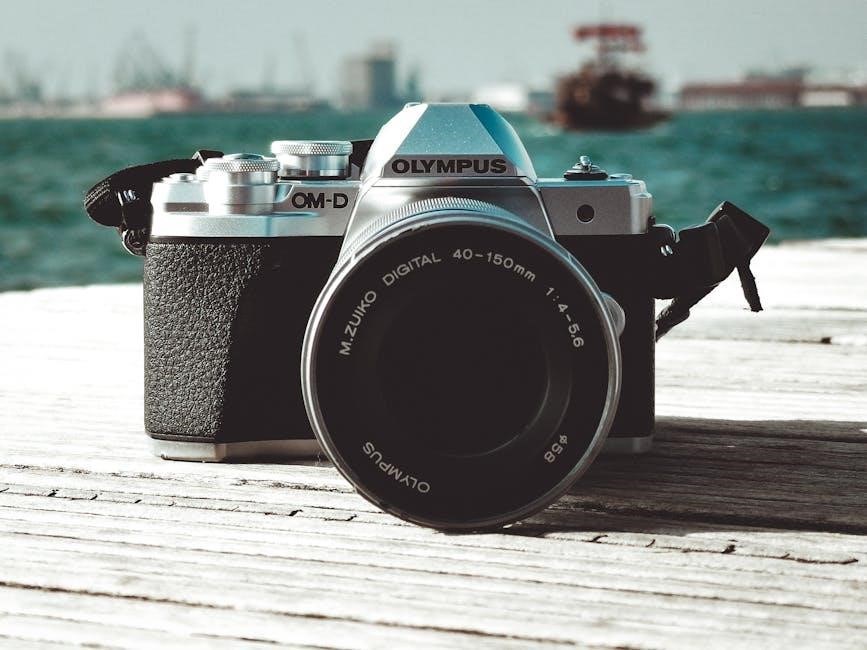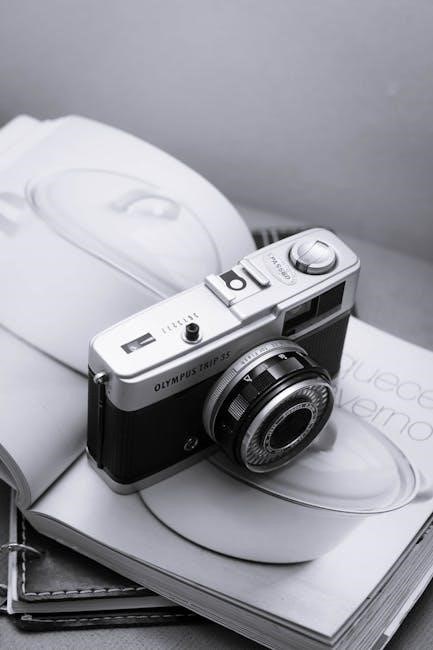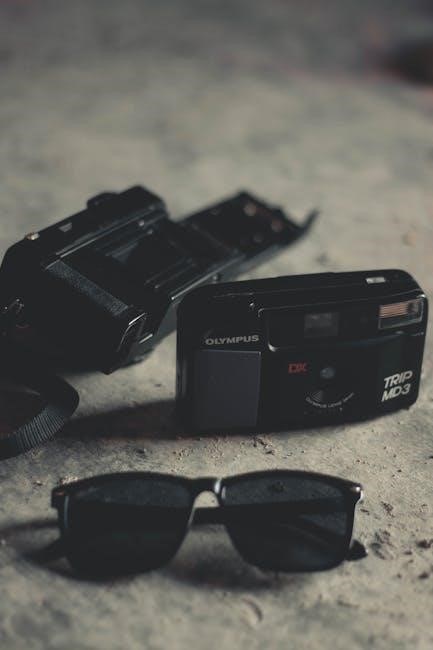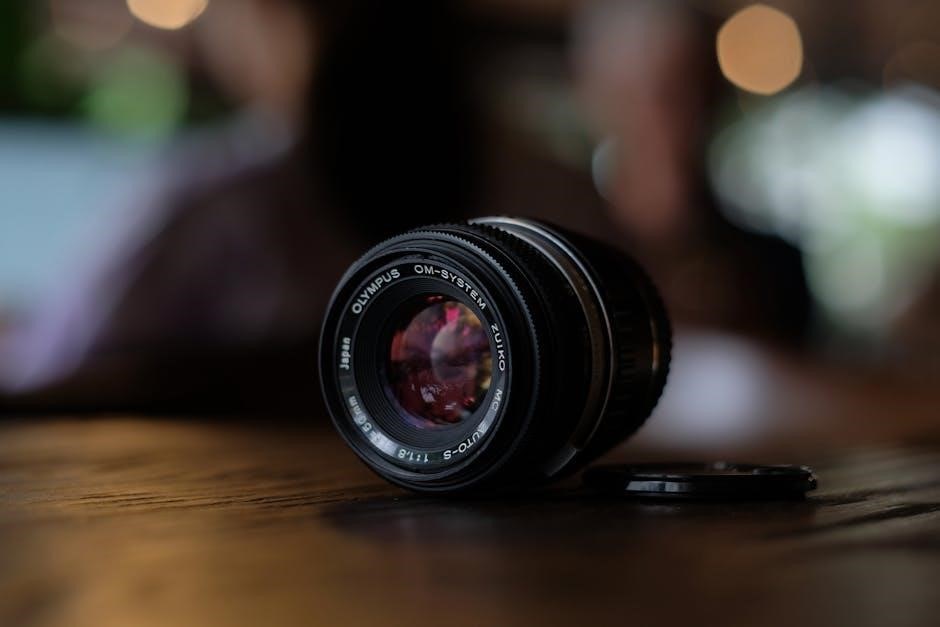Brief history and release date (June 1979)
The Olympus OM-10, a 35mm single-lens reflex camera, was introduced by Olympus in June 1979. This camera is part of the OM system, known for ease of use and accessibility for beginner photographers, offering a great introduction to film photography.
Brief history and release date (June 1979)
Launched in June 1979 by Olympus Corporation, the OM-10 marked a significant entry in the 35mm SLR camera market. Designed as part of the renowned Olympus OM system, it aimed to provide accessibility to both novice and experienced photographers. Its release underscored Olympus’s commitment to compact and lightweight design, features that defined the OM series. The OM-10 quickly gained popularity for its user-friendly interface and aperture-priority automatic exposure mode, making it a favored choice for those stepping into the world of film photography or seeking a straightforward SLR option.
Key Features and Specifications
The Olympus OM-10 boasts several key features, including its aperture priority automatic exposure mode, a compact and lightweight design for portability, and compatibility with a range of Olympus OM lenses.
Aperture Priority Automatic Exposure
In its standard configuration, the OM-10 offers aperture priority automatic exposure, simplifying the photographic process for users. This mode allows the photographer to select the desired aperture, controlling depth of field, while the camera automatically selects the appropriate shutter speed for correct exposure. This feature makes the OM-10 particularly user-friendly in various lighting situations, providing accurate exposure with minimal effort. It also offers exposure compensation for complicated lighting situations and for more creative control, allowing the user to override the camera’s automatic settings to achieve the desired effect.
Compact and Lightweight Design
The Olympus OM-10 is celebrated for its compact and lightweight design, making it a highly portable and convenient option for photographers on the go. Its smaller size compared to other SLR cameras of its era makes it easy to carry around without sacrificing functionality or image quality. This design philosophy was a hallmark of the Olympus OM series, aiming to provide a comfortable and accessible shooting experience. The reduced weight also contributes to easier handling, especially during extended use, making it an ideal choice for both beginners and experienced photographers seeking a travel-friendly camera.
Compatibility with Olympus OM Lenses
The Olympus OM-10 boasts excellent compatibility with the extensive range of Olympus OM lenses. This compatibility allows users to explore a variety of focal lengths and apertures, enhancing creative possibilities. From wide-angle lenses perfect for landscapes to telephoto lenses ideal for distant subjects, the OM system offers diverse options. The OM lenses are renowned for their sharpness and optical quality, ensuring exceptional image results when paired with the OM-10. This versatile lens system makes the OM-10 a flexible tool for photographers with different needs, offering a wide selection of lenses to adapt to various shooting scenarios and styles.
Loading Film and Batteries (LR44)
Using the Olympus OM-10 is straightforward. Load the film, insert two LR44 batteries in the base, and you’re ready. Its user-friendly design makes it perfect for beginners wanting to experience film photography with ease and simplicity.
Loading Film and Batteries (LR44)
To load film into your Olympus OM-10, first, open the camera back by lifting the rewind knob. Insert the 35mm film cartridge into the film chamber on the left side, pushing it down to ensure it’s secure. Pull the film leader across the camera body, inserting it into one of the slots on the take-up spool. Advance the film using the film advance lever until the sprocket teeth engage with the film perforations. Close the camera back and continue advancing the film a couple of times, setting the counter to ‘1’, before taking the first photo. The Olympus OM-10 requires two LR44 button cell batteries, inserted in the base.

Using the Olympus OM-10
Focusing and Metering
The Olympus OM-10 employs manual focusing. To achieve sharp focus, rotate the focusing ring on the lens until the subject appears clear in the viewfinder. The camera features a center-weighted metering system to determine proper exposure. When using aperture priority mode, select your desired aperture on the lens, and the camera will automatically select the appropriate shutter speed for correct exposure. Observe the needle in the viewfinder; it indicates the shutter speed selected by the camera based on the light meter’s reading. For optimal results, ensure the needle falls within the acceptable range. Half-press the shutter to activate the light meter.

Manual Mode and Adapter
While the OM-10 defaults to aperture-priority automatic exposure, the optional Manual Adapter unlocks full manual control. This adapter allows users to set shutter speeds manually, providing greater creative control over their photography.
Importance of Optional Manual Adapter
The Olympus OM-10, in its standard configuration, operates primarily in aperture priority automatic exposure mode, making it user-friendly for beginners. However, for photographers seeking greater creative control, the optional Manual Adapter is essential. This adapter allows the user to override the automatic system and manually select shutter speeds, enabling precise control over exposure. Without the adapter, the OM-10’s manual capabilities are limited. This adapter is particularly useful in challenging lighting situations or when aiming for specific artistic effects, providing a more versatile shooting experience. The adapter empowers photographers to fully explore the camera’s potential.
Setting Shutter Speeds Manually
With the Manual Adapter attached to the Olympus OM-10, photographers gain the ability to manually set shutter speeds, unlocking a full range of creative possibilities. The adapter typically provides a selection of shutter speeds, ranging from 1 second to 1/1000th of a second, offering precise control over exposure and motion blur. To set the shutter speed, simply rotate the dial on the Manual Adapter to the desired setting. The in-camera light meter provides suggested shutter speeds based on the chosen aperture. This manual control allows for experimentation and achieving specific photographic effects beyond the automatic mode’s capabilities.

Troubleshooting and Maintenance
Like any vintage camera, the Olympus OM-10 can experience issues. Common problems include a malfunctioning light meter, shutter inaccuracies, or film advance difficulties. Battery corrosion can also affect performance, so regular checks are essential. Cleaning the lens and mirror with appropriate materials will maintain image quality. If the shutter sticks, professional servicing might be necessary. Storing the camera in a cool, dry place with the lens cap on helps prevent fungus growth. Consult the manual for specific troubleshooting steps. With proper care and maintenance, your OM-10 can continue capturing beautiful images for years to come. Remember to handle it with care;
Owners can often find digital copies of the Olympus OM-10 manual online. These PDF manuals provide detailed instructions, specifications, and troubleshooting tips, aiding in understanding and properly using the camera’s features for enhanced photography.
Downloading the Manual
Availability of PDF Manuals
Finding a PDF version of the Olympus OM-10 manual is quite feasible, as numerous online resources offer downloadable copies. These digital manuals are invaluable for both new users and seasoned photographers, providing detailed guidance on camera operation, troubleshooting, and maintenance. Websites dedicated to camera manuals, vintage photography equipment, and online archives are excellent places to search. Having a readily accessible digital manual ensures users can quickly reference specific features, settings, or solutions, enhancing their overall experience with this classic film camera, and preserving its usability for future generations of film enthusiasts.
The Olympus OM-10 boasts compatibility with several accessories, including a dedicated flash unit and a film winder. These enhance functionality, enabling better low-light performance and faster film advance, providing a more complete shooting experience.

Accessories
Flash and Film Winder
To complement the OM-10, Olympus offered accessories like the dedicated flash, improving low-light photography. The flash ensures proper exposure in dimly lit environments. Furthermore, a film winder was available, speeding up film advancement after each shot. This accessory enabled users to capture more shots quickly, which made action photography more accessible. These additions made the OM-10 a versatile camera for various photographic scenarios, improving the overall user experience. Both accessories enhanced the functionality and broadened the creative possibilities for photographers using this system.
